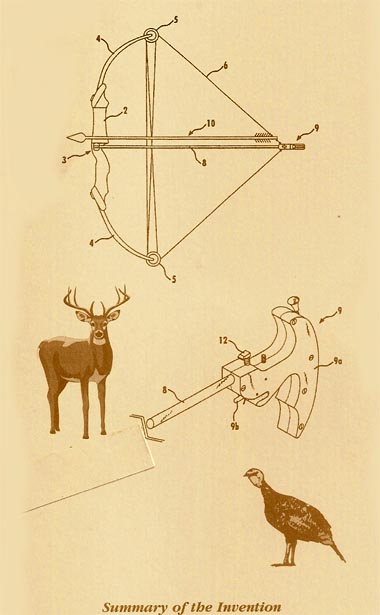
ABSTRACT
An archery bow tensioning device for holding a bow string in a fully drawn position wherein one end of a rod is freely received in and releasable from a blind bore provided in the bow handle, and the opposite end of the rod is provided with a trigger mechanism having a safety catch.
ARCHERY BOW TENSIONING DEVICE
Background of the Invention
The manual holding of a bowstring at a full draw readiness state with an arrow supported between the rest on the bow handle and its nock notched on the bowstring requires great strength on the part of the archer or bowman, particularly, if held in this state for any appreciable length of time resulting in the archer becoming weary, thereby affecting the accuracy of the arrow being shot. That is particularly true when the bow is a compound bow.
To overcome this problem, it has been proposed to fixedly mount one end of a stabilizing or tension bar to the bow handle and to provide the opposite end of the bar with a trigger mechanism for releasably holding the bowstring in the fully drawn position. This relieves the archer from manually holding the bowstring while aiming the arrow.
While these proposed stabilizing bars and associated triggers have been satisfactory for their intended purpose, they have been characterized by certain disadvantages in that the bars are permanently attached to the bow handles resulting in the bows being hulky and cumbersome, and therefore not readily storable After considerable research and experimentation, the tension device of the present invention has been devised which is freely mounted on the bow handle and releasable therefrom after the arrow has been shot; the conventional trigger mechanism has also been improved by providing a safety catch.
Summary of the invention
The tensioning device of the present invention com prises, essentially, a rod having one end adapted to be freely received within a recessed blind bore provided in the bow handle. The opposite end of the rod is provided with a trigger mechanism having a safety latch to prevent the inadverrent shooting of an arrow. If the how handle is matte of metal, the recessed blind bore is provided by drilling a bore into the handle of the bow. If the bow is made of wood, a fitting having a recessed blind bore is threadably mounted in the handle. By this construction and arrangement, various types of bows can be retrofitted to accommodate the tensioning device of the present invention.
